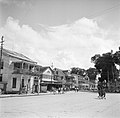History
Paramaribo was founded in 1613 by Stoffel Albertszoon near the indigenous village Parmurbo. [3] Around 1665, during the British occupation, the village was expanded and quickly outranked the earlier settlement of Torarica. [4]
The historical centre dates from the 17th and 18th century, and is mainly composed of wooden houses in a plain and symmetrical style, and the street are set in a grid structure. [2] The reason for using wood was that the absence of stone in the vicinity, and the clay was not suitable for bricks. Only important administrative buildings were built from stone shipped from the Netherlands. [5]
In January 1821, a fire consumed the area around Oranjeplein (current name: Onafhankelijkheidsplein [6] ) and Waterkant, the oldest part of the city. More than 400 buildings were lost, and it is the reason why the oldest part of the city centre has many 19th century buildings. [7] In 1832, 46 houses burnt down. [7] The slaves Kodjo, Mentor, and Present were found guilty of arson, and burnt alive. [8]
Even though the centre has been constructed using a wide grid, the houses are spaced relatively close together. The reason is that the slaves, and freed slaves lived in little shacks behind the main façade. [9]
This page is based on this
Wikipedia article Text is available under the
CC BY-SA 4.0 license; additional terms may apply.
Images, videos and audio are available under their respective licenses.














